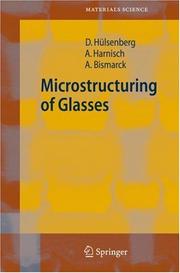| Listing 1 - 4 of 4 |
Sort by
|

ISBN: 1281512702 9786611512705 3540498885 3540262458 3642065716 Year: 2008 Publisher: Berlin, Heidelberg : Springer Berlin Heidelberg : Imprint: Springer,
Abstract | Keywords | Export | Availability | Bookmark
 Loading...
Loading...Choose an application
- Reference Manager
- EndNote
- RefWorks (Direct export to RefWorks)
As microstructured glass becomes increasingly important for microsystems technology, the main application fields include micro-fluidic systems, micro-analysis systems, sensors, micro-actuators and implants. And, because glass has quite distinct properties from silicon, PMMA and metals, applications exist where only glass devices meet the requirements. The main advantages of glass derive from its amorphous nature, the precondition for its - theoretically - direction-independent geometric structurability. Microstructuring of Glasses deals with the amorphous state, various glass compositions and their properties, the interactions between glasses and the electromagnetic waves used to modify it. Also treated in detail are methods for influencing the geometrical microstructure of glasses by mechanical, chemical, thermal, optical, and electrical treatment, and the methods and equipment required to produce actual microdevices.
Glass. --- Microstructure. --- Nanostructured materials. --- Nanomaterials --- Nanometer materials --- Nanophase materials --- Nanostructure controlled materials --- Nanostructure materials --- Ultra-fine microstructure materials --- Microstructure --- Nanotechnology --- Materials --- Matter --- Morphology --- Micromechanics --- Stereology --- Amorphous substances --- Ceramics --- Glazing --- Constitution --- Nanotechnology. --- Surfaces (Physics). --- Condensed Matter Physics. --- Ceramics, Glass, Composites, Natural Materials. --- Optics, Lasers, Photonics, Optical Devices. --- Characterization and Evaluation of Materials. --- Physics --- Surface chemistry --- Surfaces (Technology) --- Molecular technology --- Nanoscale technology --- High technology --- Condensed matter. --- Ceramics. --- Composites (Materials). --- Composite materials. --- Lasers. --- Photonics. --- Materials science. --- Material science --- Physical sciences --- New optics --- Optics --- Light amplification by stimulated emission of radiation --- Masers, Optical --- Optical masers --- Light amplifiers --- Light sources --- Optoelectronic devices --- Nonlinear optics --- Optical parametric oscillators --- Composites (Materials) --- Multiphase materials --- Reinforced solids --- Solids, Reinforced --- Two phase materials --- Ceramic technology --- Industrial ceramics --- Keramics --- Building materials --- Chemistry, Technical --- Clay --- Condensed materials --- Condensed media --- Condensed phase --- Materials, Condensed --- Media, Condensed --- Phase, Condensed --- Liquids --- Solids
Digital
ISBN: 9783540498889 Year: 2008 Publisher: Berlin, Heidelberg Springer-Verlag Berlin Heidelberg
Abstract | Keywords | Export | Availability | Bookmark
 Loading...
Loading...Choose an application
- Reference Manager
- EndNote
- RefWorks (Direct export to RefWorks)
Electronics and optics of solids --- Solid state physics --- Materials sciences --- Electrical engineering --- Chemical technology --- composieten --- materiaalkennis --- nanotechniek --- fysica --- chemische technologie --- optica
Book
ISBN: 9783540498889 Year: 2008 Publisher: Berlin Heidelberg Springer Berlin Heidelberg
Abstract | Keywords | Export | Availability | Bookmark
 Loading...
Loading...Choose an application
- Reference Manager
- EndNote
- RefWorks (Direct export to RefWorks)
As microstructured glass becomes increasingly important for microsystems technology, the main application fields include micro-fluidic systems, micro-analysis systems, sensors, micro-actuators and implants. And, because glass has quite distinct properties from silicon, PMMA and metals, applications exist where only glass devices meet the requirements. The main advantages of glass derive from its amorphous nature, the precondition for its - theoretically - direction-independent geometric structurability. Microstructuring of Glasses deals with the amorphous state, various glass compositions and their properties, the interactions between glasses and the electromagnetic waves used to modify it. Also treated in detail are methods for influencing the geometrical microstructure of glasses by mechanical, chemical, thermal, optical, and electrical treatment, and the methods and equipment required to produce actual microdevices.
Electronics and optics of solids --- Solid state physics --- Materials sciences --- Electrical engineering --- Chemical technology --- composieten --- materiaalkennis --- nanotechniek --- fysica --- chemische technologie --- optica
Book
ISBN: 9814566462 9789814566469 9789814566452 9789814566483 9789814566490 9789814566506 9789814566513 9814566454 Year: 2014 Publisher: Hackensack, New Jersey
Abstract | Keywords | Export | Availability | Bookmark
 Loading...
Loading...Choose an application
- Reference Manager
- EndNote
- RefWorks (Direct export to RefWorks)
Green materials and green nanotechnology have gained widespread interest over the last 15 years; first in academia, then in related industries in the last few years. The Handbook of Green Materials serves as reference literature for undergraduates and graduates studying materials science and engineering, composite materials, chemical engineering, bioengineering and materials physics; and for researchers, professional engineers and consultants from polymer or forest industries who encounter biobased nanomaterials, bionanocomposites, self- and direct-assembled nanostructures and green composite
Nanostructured materials. --- Nanomaterials --- Nanometer materials --- Nanophase materials --- Nanostructure controlled materials --- Nanostructure materials --- Ultra-fine microstructure materials --- Microstructure --- Nanotechnology
| Listing 1 - 4 of 4 |
Sort by
|

 Search
Search Feedback
Feedback About
About Help
Help News
News